 |  |
Article and photos by David Kier
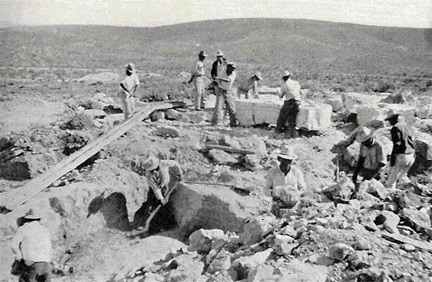
The abandoned onyx quarry and mine town of El Marmol near El Rosario makes for an interesting and unique Baja excursion. The site is famous as being the location of the world's only onyx schoolhouse. Mining the stone began soon after the deposit was discovered around 1900. The location was first called 'El Tule' then 'Onyx' on old maps before the final name, which is the Spanish word for marble and onyx. The deposit at El Marmol covers an area 1200 feet wide, 3000 feet long and 40 or more feet thick.
Onyx is formed by springs depositing layer upon layer of lime-laden water over time. These types of water deposits also create limestone and marble, but onyx is much harder and thus polishes nicer. This process of onyx formation can be witnessed today about 4 miles east at El Volcan where active soda springs are currently laying down new deposits that may become onyx in a few thousand years.
The Southwest Onyx and Marble Company of San Diego started working this site around 1905. A prospector discovered the beautiful stone deposit and soon it would become the largest onyx quarry on earth. Kenneth Brown and his father before him managed the operation. Prior to onyx, the Brown family mined copper on Isla Cedros, off the west coast of central Baja California.
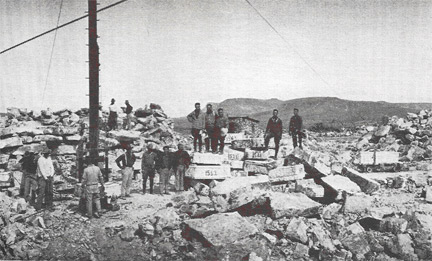
Onyx harvested from El Marmol was used to make ornamental objects, inkwells, bookends, statues, and more. A bathtub for the silent film era's vamp Theda Bara came from a block of El Marmol onyx. In 1936, a 60-ton, 38-foot high statue named Vision of Peace, in Saint Paul, Minnesota was made from El Marmol's blocks of onyx. Originally named 'Indian God of Peace', it is considered the largest carved onyx statue in the world. The giant statue sits on a slowly revolving base at the entrance to the city hall and county courthouse in Saint Paul.
The process of mining the onyx was simple compared to the difficulty of transporting the heavy blocks to San Diego. The blocks were originally taken by mule train to Puerto Santa Catarina, some 50 miles away. At that point, trucks with solid rubber tires would replace the mules. Once they arrived at the beach, the blocks then were ferried through the surf to ships. As roads in Baja continued to improve, the blocks were eventually trucked from the El Marmol all the way to San Diego.
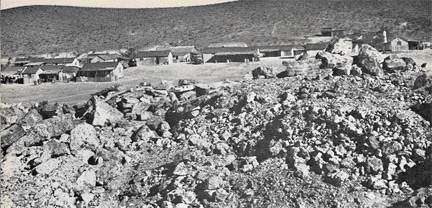
With the advent of plastics after World War II, the demand for genuine carved onyx dropped, and the mine closed in 1958. Nothing else could keep people living in such a harsh place and so the town of 115 people vanished, leaving only the onyx made schoolhouse behind. Over the years, artists began collecting small quantities from the site for carvings. Sadly, nearly half of the onyx schoolhouse was demolished for the stone. Since then, a fence was erected to serve as a protection or perhaps to show it has some value as a historic site. The onyx quarry along with the schoolhouse, some concrete slabs, and a graveyard are all that remain of the town today.
Getting to El Marmol is not difficult and only it is 9.3 miles from Highway One on a mostly level, graded road. A sign marks the turnoff 56.5 miles from the El Rosario Pemex station, near Km. 148/149. As you approach El Marmol, you will see the graveyard on the right, and then pass the road left to El Volcan and La Olvidada. The remains of the schoolhouse are just beyond.
Pickup trucks or four-wheel drive vehicles can go 4 miles northeast to Arroyo el Volcan where soda springs and a rare cold-water geyser are making future onyx deposits. To find the site, set odometer at the schoolhouse and take the road northeast to a fork at Mile 2.0. Turn right, and drop steeply downhill to the bottom at Mile 4.0, in the El Volcan arroyo. The geyser site is up the arroyo to the right (south), less than half a mile (it may be possible to drive half the distance in the arroyo and walk the remainder). Many pools of water and mineral deposits make it an interesting visit. If by luck, you could witness the monthly eruption of El Volcan. The soda-powered geyser is reported to spew a 60-foot fountain for several minutes!
The road beyond Arroyo el Volcan passes a mineral stained slope of tiny springs at Mile 4.2 from El Marmol and once continued to the La Olvidada barite mine at Mile 10.3. The road has been washed out before reaching the mine, but the views of the Sea of Cortez and wild countryside await those who take it.
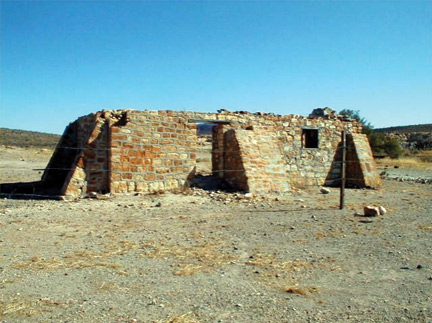

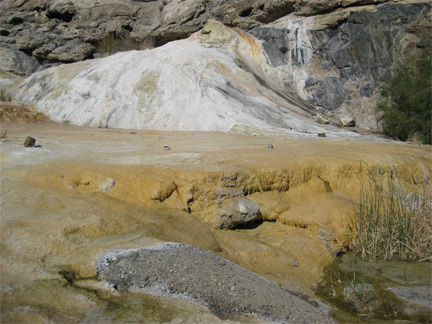
Historical photo credits (from top to bottom):
El Marmol miners in 1941 - Photo by Max Miller
The quarry and miners - Photo by Walt Wheelock
The onyx schoolhouse - Photo by Ralph Hancock
El Marmol in 1953 - Photo by Ralph Hancock